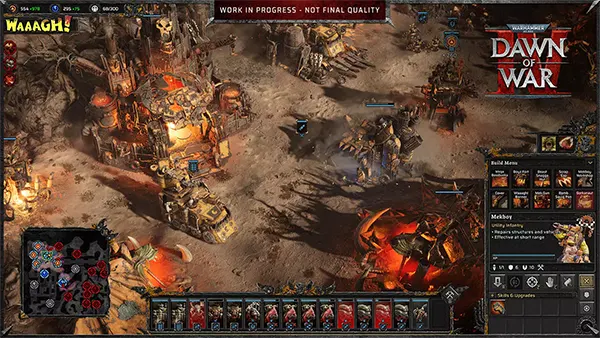
Warhammer 40,000: Dawn of War 4 – A Classic RTS in the Warhammer Universe
The real-time strategy genre has been defined by the Warhammer 40,000 series, known for its large-scale battles, complex mechanics, and rich lore. Dawn of War 4, expected to continue this legacy, promises to bring modern refinements while staying faithful to the tactical depth and atmosphere that have made the series iconic among strategy fans.
Core Strategic Mechanics
Dawn of War 4 is set to preserve the essence of classic RTS gameplay, focusing on resource gathering, base construction, and tactical unit control. Players will need to plan their economy, secure territories, and adapt their strategies dynamically as battles unfold. This balance between macro and micro management has always been a central strength of the series.
Each faction will offer distinct tactical approaches, with unique units, strengths, and weaknesses. This asymmetry challenges players to understand and exploit their chosen faction’s advantages while countering the enemy’s. Careful balancing will be crucial for ensuring competitive integrity and long-term replayability in both single-player and multiplayer modes.
Modern AI systems are expected to enhance the solo experience, making computer-controlled opponents more responsive and adaptive. Instead of predictable patterns, the AI will analyse player behaviour and adjust strategies, offering a more dynamic and challenging campaign for experienced players.
Campaign and Narrative Depth
The campaign will continue to be rooted in the grimdark lore of the Warhammer 40,000 universe, where brutal conflict defines every star system. Players are likely to experience intertwining storylines from multiple faction perspectives, offering different moral viewpoints and military doctrines. This approach enriches the storytelling and gives players a reason to explore every side of the war.
Cinematic sequences and voice-acted dialogues are expected to play a significant role, immersing players in the personal stories of commanders and soldiers. These narrative elements can create a strong emotional connection, making strategic victories and losses feel impactful on a human level.
Player choices may influence the direction of the story, allowing for branching paths and multiple outcomes. Such narrative flexibility encourages replaying the campaign and deepens engagement with the game world beyond its strategic mechanics.
Multiplayer and Competitive Play
Multiplayer has always been a cornerstone of the Dawn of War series, and the fourth instalment is anticipated to refine this aspect further. The game will likely include ranked matchmaking, custom lobbies, and tournaments, supporting both casual and competitive communities. Balancing and regular updates will be crucial to sustain a healthy competitive scene.
Faction diversity will play a vital role in shaping multiplayer dynamics. Each faction’s unique tech tree and unit composition will demand distinct strategies, rewarding players who master their chosen side while learning to counter others. This fosters a constantly evolving metagame and keeps matches unpredictable and engaging.
Improved networking infrastructure and dedicated servers are expected to provide stable performance and minimise latency issues. This technical foundation is essential for ensuring fair and smooth online battles, particularly during large-scale engagements involving dozens of units on screen.
Esports Potential
The competitive structure of Dawn of War 4 positions it as a potential candidate for modern esports. The combination of fast-paced tactical decision-making and long-term strategic planning can make matches thrilling for spectators while rewarding skill and preparation among players.
To support esports growth, developers are expected to include detailed spectator tools, replays, and live match analytics. These features can make tournaments more accessible to viewers and help commentators explain the complexity of battles in real time.
Community-driven leagues and tournaments will also be key, allowing grassroots events to build momentum and nurture new talent. By supporting both professional and amateur competitions, the game could establish a vibrant and sustainable competitive ecosystem.

Technological Advancements and Visual Design
Dawn of War 4 is likely to take full advantage of current-generation hardware, delivering highly detailed models, realistic lighting, and large battlefields filled with dynamic environmental effects. These visual improvements can enhance immersion while clearly conveying battlefield information for strategic decision-making.
Sound design will also play an important role. Distinct audio cues for units, abilities, and combat events can provide players with critical situational awareness. Combined with an atmospheric soundtrack, this audio layer helps build tension and excitement during intense clashes.
Performance optimisation is expected to be a major priority, ensuring smooth gameplay even during massive battles involving hundreds of units. Scalable graphics settings will allow players on a wide range of systems to experience the game without compromising strategic clarity or visual quality.
Future Support and Community
Post-launch support will be essential to maintaining player interest. Regular balance patches, new content expansions, and quality-of-life improvements can extend the game’s lifespan and keep its community active and engaged. Transparent communication from the developers will help maintain trust and enthusiasm among players.
Modding support may also return, empowering players to create custom maps, units, and scenarios. This creative freedom has historically kept RTS communities thriving long after release and could significantly boost Dawn of War 4’s longevity.
By nurturing an active player base and encouraging user-generated content, the game can evolve continuously, ensuring it remains relevant and enjoyable well beyond its initial release year.


